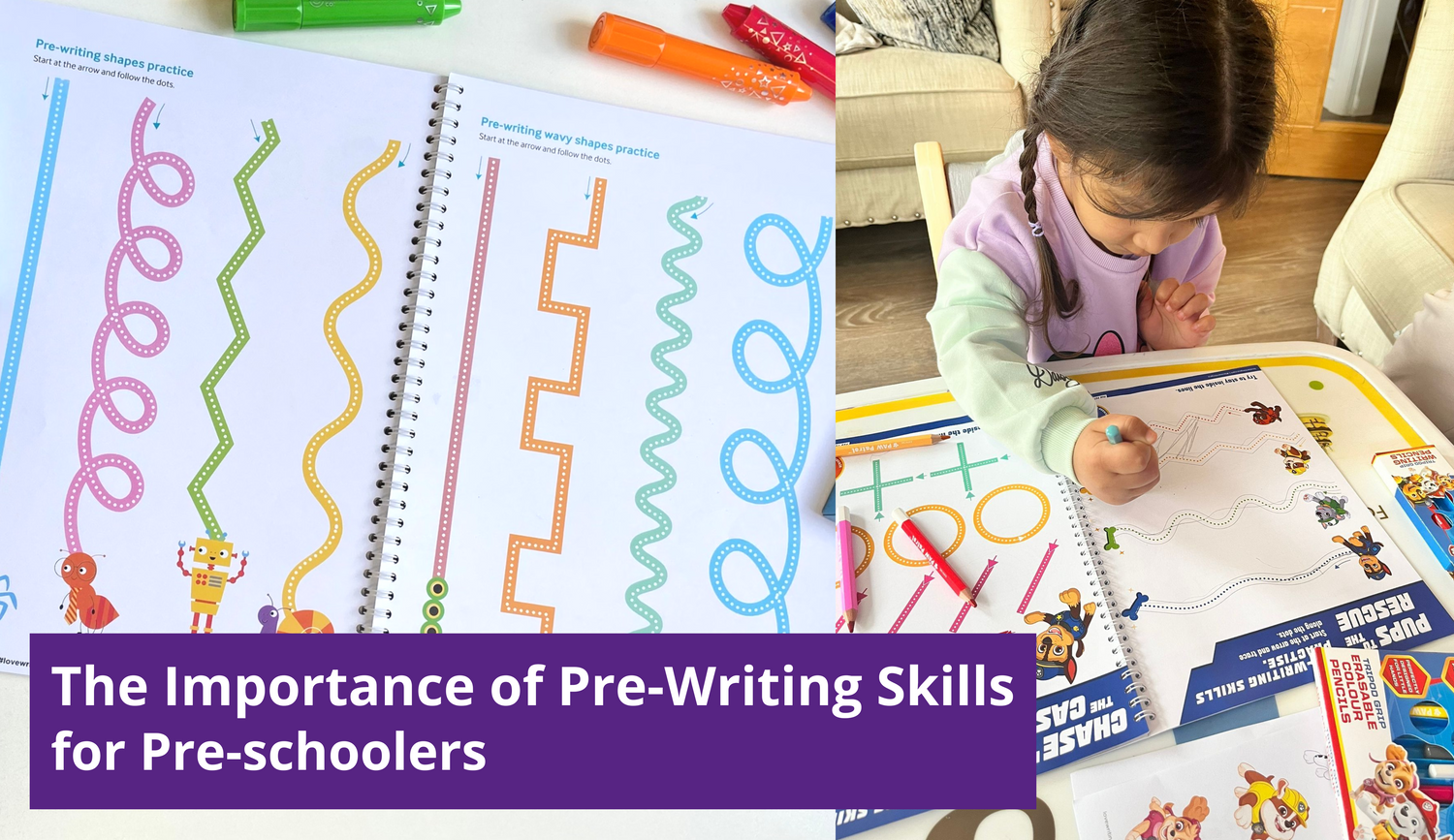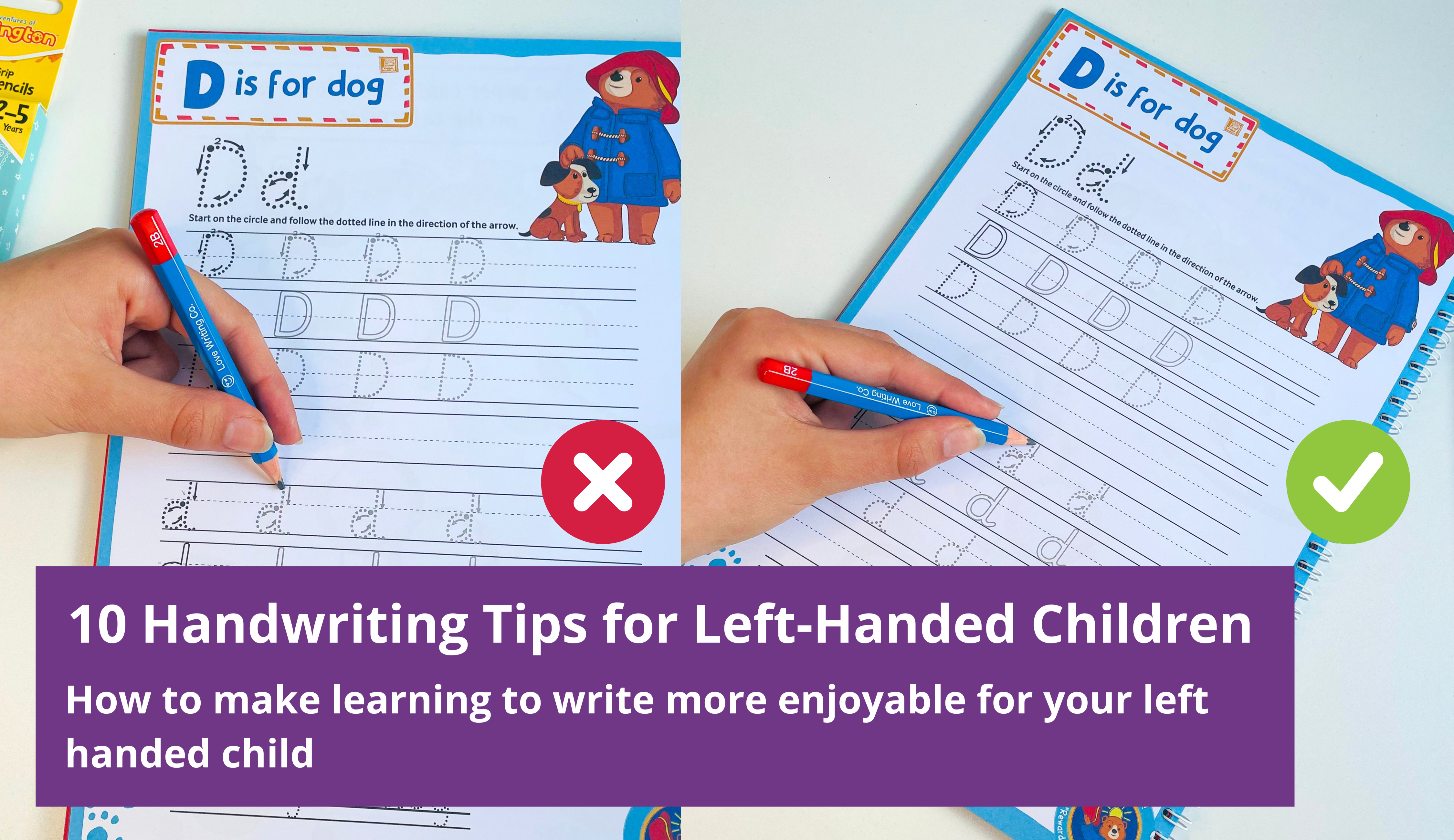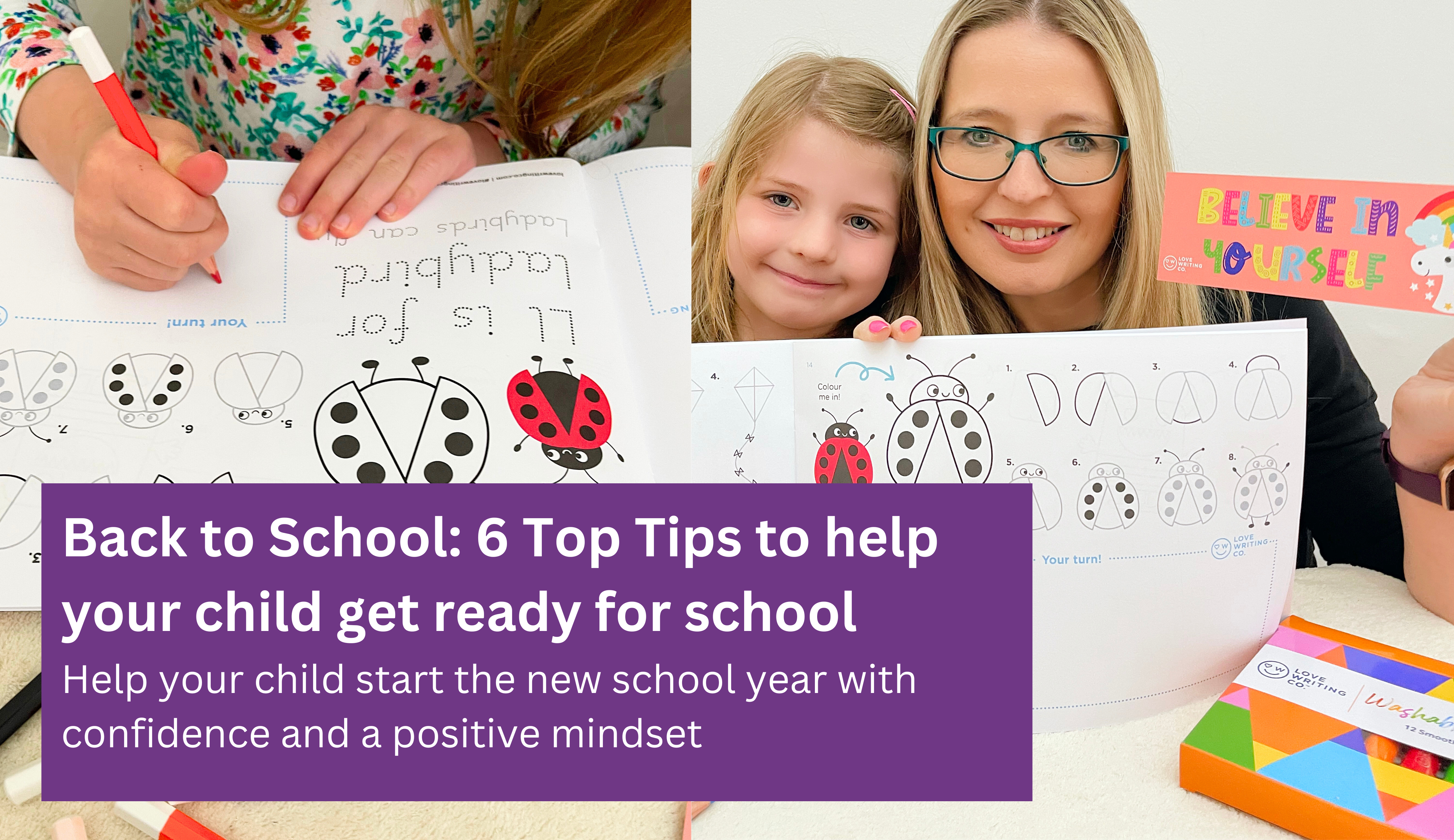By Love Writing Co.
So what are pre-writing skills and why are they so important? How can you help your child to start their learning to write journey in a fun way that inspires a love of writing that lasts a lifetime? We're here to help you do just that!
Pre-writing skills are the fundamentals children need to learn and develop before they are able to write letters of the alphabet, form words or numbers. These skills contribute to a young child's ability to hold and use a pencil, and the ability to draw, write, copy, and colour.
Keep reading to learn more about pre-writing skills and why they are a essential first step in your child’s learning to write journey.
In this blog we will be discussing;
- What are pre-writing skills?
- Why are pre-writing skills important?
- Fun pre writing skills crafts and activities for kids - and where you can buy these. Perfect for home learning
Pre-writing skills - What are they?
Writing is a process that begins long before a child learns to form or even recognise letters. Building prewriting skills through mark-making activities are the very first steps in your child's learning to write journey.
Pre-writing skills are the basic lines and shapes children need to be able to draw before they can write the letters of the alphabet.
- Vertical line
- Horizontal line
- Circle shape
- Triangle shape
- Cross shape
- Right/left diagonal line
- ‘X’ shape
You can buy these pre-writing skills activity books shown above (and many more) here.
To master these shapes there are lots of other skills your child can practice to help improve their pre-writing ability.
You may have heard of a few of these below, we've explained a little more about them and ways you can try to improve their skills at home:
Fine motor skills involve the coordination of the small muscles in the hands and fingers and help us to perform small and precise tasks. These skills not only improve your child’s pencil grip but helps your child to perform important everyday tasks like fastening clothes, tying shoe laces or eating dinner
Gross motor skills involve the coordination of the larger muscles in our body like our arms, legs and torso. Activities like walking, running or jumping help to improve our gross motor skills and help to improve balance, posture and physical strength. Strength and stability provided by the shoulder to allow controlled hand movement and good pencil control.
Hand-eye coordination involves the coordination between the hands and eyes. It enables children to guide their hand movements based on visual information.
Crossing the midline The ability to cross the imaginary line running from a person’s nose to pelvis that divides the body into left and right sides.
Bilateral coordination Bilateral coordination refers to the ability to use both hands together in a coordinated manner. It is essential for activities like stabilising the paper with one hand while writing with the other. Playing catch, clapping, or using both hands to manipulate objects can improve bilateral coordination.
Letter and shape recognition is an important skill when learning to write. Children should be exposed to letters, numbers, and shapes early on. Try a multisensory approach to learning and use visual aids like flashcards or hands-on activities like playdough tracing, sensory trays or pavement chalk. Check out these super fun multisensory writing activities we did below!
You can find out more about letter recognition and learning to write their name in other blog we've done - we have linked it at the end for you.
Spatial awareness involves understanding the relationship between objects in space. It helps children correctly position letters, words, and sentences on a page. Activities such as puzzles, building blocks, and arranging objects in different patterns can enhance spatial awareness.
Hand-eye coordination involves the coordination between the hands and eyes. It enables children to guide their hand movements based on visual information. Activities like drawing, colouring, and playing with building blocks can enhance hand-eye coordination.
Why are pre-writing skills so important?
Pre-writing skills help us to improve handwriting skills, build fine motor skills and gets children ready for a successful learning to write journey
Practising tracing lines, shapes and mark-making are all important steps a child must take before they are ready to learn to form letters and words.
Here we are discussing all the reasons why these beginner skills are essential for a child's education:
1. Builds independence & confidence
Developing fine motor skills make it easier to learn to hold a pencil correctly and comfortably, meaning children can enjoy writing for longer periods of time. When a child learns to comfortably hold their pencil in the correct dynamic grip, form letters and organise their ideas on paper, they gain confidence in their writing ability and become confident independent writers.
Learning with a positive attitude motivates children to challenge themselves and want to achieve more, this confidence extends beyond learning to write and positively impacts other areas of a child’s academic and social lives.
2. Learn letter and word formation
Pre-writing shapes include the directional movements a child needs to make to be successful with writing. When learning to write we must first learn to form, recognise and differentiate letters of the alphabet.
Children should be exposed to letters, numbers, and shapes early on. Recognizing and differentiating between these different shapes is an important skill when learning to write. Learning to understand all the different ticks and flicks is the trickiest part!
Try a multisensory approach to learning and use visual aids like flashcards or hands-on activities like playdough tracing, sensory trays or pavement chalk.
Go to our Pinterest here to see even more fun play ideas.
Also, check us out on socials @lovewritingco Instagram, TikTok. Facebook for more learning ideas. Join our community today for advice, tips and free resources.
3. Develop good handwriting skills
Developing pre-writing skills helps children acquire the necessary fine motor control and coordination to write legibly and efficiently. By strengthening their hand muscles and refining their hand-eye coordination, children can produce more controlled and accurate handwriting.
4. Academic confidence
Children who practice their pre-writing skills will find pre-cursive writing easier, then as they progress find cursive handwriting easier and so on. Developing pre-writing skills is the first step to a quick, easy and most importantly fun learning to write journey! This will help to create academic confidence throughout their learning journey.
Early years education sets the foundation for academic success and supports your child's transition from preschool to big school with confidence - a positive transition is important for children as they are happy, comfortable and motivated to learn!
5. Cognitive development
Cognitive skills means to think, explore and understand the world around us. Cognitive development improves perception, attention, memory, decision making and communication skills.
Learning to form letters and differentiate all the different ticks and flicks helps to improve attention span and memory skills. We also improve our language and communication skills through problem solving, decision making and communicating our feelings clearly and effectively.
Picture using: "My First pre-Writing skills" activity book. Linked for you here.
By focusing on these pre-writing skills, children can develop the necessary foundation to become confident writers later on. Encouraging activities that promote fine motor skills, hand-eye coordination, and spatial awareness can greatly support their writing readiness and tripod grip.
It's important to encourage the correct pencil grip because it allows children to learn to write comfortably, confidently and for longer periods of time. We can do this by providing children with the correct writing tools!
Here at Love Writing Co. we have developed a Pre-writing Skills Activity Book for Kids!
This brand new activity book supports your child with pre-writing activities which support their ability to begin to form letters, words and numbers.
- 48 Pages of fun pre writing practice plus 24+ FREE reward stickers!
- Tripod Grip Writing Pencils 5 Pack Ages 2-5: Helps them adopt a dynamic tripod grip with ease and comfort.
Picture: "My First pre-Writing skills" activity book. Linked for you here.
Embark on an exciting adventure in early writing with 'My First Pre-Writing Skills' Activity Book with the incredible PAW Patrol, meticulously designed to nurture the foundational skills necessary for your child to learn to write
Picture learn pre-writing skills with the PAW PATROL - Linked for you here.
- 58 Pages of PAW Patrol fun learning (Plus 35 FREE Reward Stickers): Engage with their favourite characters fun fun-filled learning, including Chase, Ryder, Marshall, Skye, Rocky, Rubble, Zuma & More.
- PAW PATROL Erasable Tripod Grip Colour Pencils Pack of 12 Ages 2-5: Ergonomic design for little hands, break-resistant construction, promotes comfortable writing and more.
- PAW PATROL Tripod Grip Writing Pencils 5 Pack Ages 2-5: Helps them adopt a dynamic tripod grip with ease and comfort.
- Supports gross motor skills and encourages good posture
- Helps your child pass the ‘midline’ movement ability
- Develop and strengthen fine motor skills
- Establish a solid pencil grip foundation
- Form basic pre-writing essential pattern skills
- Grow confidence when writing with a pencil & mark-making
Fun Pre Writing Skills Activities you can try at home:
Playdough tracing
Making different letters and shapes with playdough to strengthen our hands and build dexterity in our fingers will help to improve fine motor skills and build good pencil grip and control.
Pavement chalk
An all time favourite of ours and the perfect outdoor activity is using pavement chalk! Playing outside with pavement chalk making big movements and mark making all help to improve our fine and gross motor skills.
Colouring Activity Sheets
Fun colouring activity sheets is such a simple way to build pre-writing skills and improve hand and finger strength. Drawing and colouring activity sheets is a fun, cost effective way to keep children practising their handwriting skills whilst also having fun!
Drawing with cars
Using our 3-in-1 Washable Arty Crayons, attach to the back of a toy car and have your child drive around and mark a trail behind. Draw some buildings, traffic lights or people and let them draw their own roads and pathways to make their very own city map!
Q-tip painting
Grab some cotton sticks/q tips and use them as paintbrushes! Dip your cotton sticks into some paint and dot by dot trace over different shapes, patterns or letters. You could try some printable template sheets or draw out a tree and paint on all the leaves - this is such a fun activity and plus teaches your child all about the different seasons in the year!
Sensory tray
Fill up a tray with some sand, sugar, or crushed up cereal (this is a great idea because it's a tasty treat & safe to eat!) Give your child different shapes, patterns or letters to trace with their fingers.
Get your perfect home learning essentials today. Links on where to get all of these fantastic resources mentioned above:
Shop Pre-Writing Skills Packs Early Learning Essentials Ages 2-5
The perfect beginners set for early years pre-writers packed with pre-writing activities tracing lines, curves, waves, loops, spirals, shapes and fun colouring which supports their ability to begin to form letters, words and numbers.
Shop Tripod Grip Writing Tools :
Small, chunky, hexagonal writing pencils. Designed to be the correct length for children and with a wider diameter, softer core and hexagonal shape, our pencils prevent muscle fatigue and encourage the correct tripod grip, promoting a love of writing from an early age
Shop all Children's Fun Handwriting Resources Ages 3-9 :
Shop our entire collection here: www.lovewritingco.com
That's all from us this time - we really hope you all of these tips and advice as much as we do.
Love from,
Love Writing Co. x
You might enjoy reading our other popular blog too:
How to help your child to write their name easily
https://lovewritingco.com/blogs/blog/how-to-teach-your-child-to-write-their-name-easily

















5 comments
vikramschool
I really enjoyed your post! Provides information on how prewriting strengthens fine motor control, hand-eye coordination, and cognitive readiness, paving the way for confident, legible early writing.
Kidskastle
The purpose of this blog is to provide valuable insights into the importance of pre-writing skills for preschoolers, emphasizing their importance in laying the foundation for future writing abilities.
kidscastle
Pre-writing skills help preschoolers develop fine muscle control and coordination. Drawing shapes, practicing handwriting, and engaging in related activities prepare them for successful writing experiences.
Anna
Great advice and will help my four year old for sure
Bonnie
Really informative and definitely will look into the range thanks
Leave a comment
All comments are moderated before being published.
This site is protected by hCaptcha and the hCaptcha Privacy Policy and Terms of Service apply.